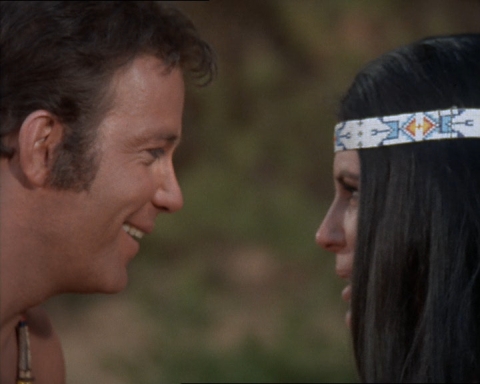Case Study: “The Paradise Syndrome” (1968)
Originally titled “Pale Face,” the story outline by Margaret Armen uses well-worn racialized adjectives and cliches to construct the Native-American tribe as noble savages. Kirk, Armen writes, “has found this tribe gentle, kind, and in complete attune with nature.” Armen has Kirk being accepted into the tribe and marrying one of the women, Miramanee. This emphasizes the mythical structure of the story, that of the so-called paradise syndrome, which typically involves a white man escaping civilization or getting lost in the wild, befriending a wise but simple tribe of natives, falling in love with a submissive and often scantily clad native girl, and, after saving the natives from an event or person bent on destroying them, eventually determining that living among them is not his life’s mission. The white man, not the native, has evolved, and he must accept his role as a complex, civilized human. In Armen’s outline, Kirk realizes that Miramanee “can never fit into [his] world. Simple and gentle as she is, her only place is the idyllic tribal environment of her people. Gently, he tells her that he no longer fits into her world either, that the ancient prophecy has been fulfilled and he must go on to fulfill his further duty.” The outline concludes: “He knows a part of him—the part of man that is always pagan—will always remain behind, that a poignant longing for the idyllic life of the noble savage will never leave him.”
The noble savage stereotype found in the development of “The Paradise Syndrome” functions as a sort of fetish, much like its eighteenth-century predecessor, analyzed by metahistorian Hayden White: “belief in the idea of a Noble Savage was magical, was extravagant and irrational in the kind of devotion it was meant to inspire, and, in the end displayed the kind of pathological displacement of libidinal interest that we normally associate with the forms of racism that depend on the idea of a ‘wild humanity’ for their justification.” All three aspects of White’s noble savage fetish are played out in Armen’s outline. First, the Indians are associated with magical qualities, especially in the representation of them as being mysteriously connected to—“in complete attune with”—nature. Second, the representation of the Indians as existing in some pristine and unchanging condition—on another planet, no less—reveals an irrational devotion to a particular image of Native-Americans as “noble,” an image “fixed” in time like the fetish. This is perhaps most prominent in both the super-race’s efforts to preserve them and Kirk’s nostalgic longing to become one of them. Finally, the stereotype is strongly suggestive of a libidinal displacement, perhaps most clearly projected in the relationship between Kirk and Miramanee—in which the captain, after falling in “love” with the beautiful native, has nothing less than a “wild” time.
The use of the noble savage theme in the conceptualization of “The Paradise Syndrome” ultimately has less to do with the lifestyle and customs of Native-Americans than with the evolution of whiteness. In his analysis, White goes on to argue that the noble savage fetish ultimately “draws a distinction, in the nature of an opposition, between normal humanity (gentle, intelligent, decorous, and white) and an abnormal one (obstinate, gay, free, and red).” The “abnormality” of an otherwise noble humanity cannot be understood outside the notion of a wild/savage humanity (Indians), which itself cannot be understood outside the notion of a “normal”—and, at least rhetorically, superior—humanity (whites). Such an opposition thus becomes a way to define the superior “civility” of whiteness, which in the making of “The Paradise Syndrome” is especially evident in Roddenberry’s efforts to ensure that the Indians, despite centuries of unencumbered evolution on a far-off planet, haven’t really evolved. In a memorandum to Fred Freiberger, the producer of Star Trek during its third season, Roddenberry states his case in explicit terms:
Roddenberry’s insistence on representing the tribe as having advanced only far enough to invent the wheel reveals a hierarchy of cultures that has whites “naturally” on top of an evolutionary ladder—a telling contradiction in his liberal-humanist project.


No comments:
Post a Comment